Introduction
Physical therapy in West Orange for Pain Care
Welcome to Optimum Recovery Rehab Physical Therapy & Rehabilitation's resource about Piriformis Muscle Injections.
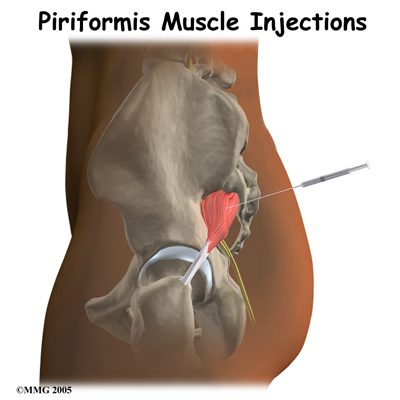 Piriformis muscle injections are commonly used to determine what is causing buttock and sciatica type pain. Piriformis muscle injections are both diagnostic injections and therapeutic injections, meaning that they can both help your health care professional determine the cause of your pain and may also provide you with relief from the pain. These injections work to eliminate pain temporarily by paralyzing the piriformis muscle and stopping spasm in the muscle. If the piriformis muscle is injected and your pain goes away for several days, then it is very likely that a portion of your pain is caused by piriformis syndrome. Once you and your health care professional know what structure is causing your pain, you can begin to explore options for treating the condition.
Piriformis muscle injections are commonly used to determine what is causing buttock and sciatica type pain. Piriformis muscle injections are both diagnostic injections and therapeutic injections, meaning that they can both help your health care professional determine the cause of your pain and may also provide you with relief from the pain. These injections work to eliminate pain temporarily by paralyzing the piriformis muscle and stopping spasm in the muscle. If the piriformis muscle is injected and your pain goes away for several days, then it is very likely that a portion of your pain is caused by piriformis syndrome. Once you and your health care professional know what structure is causing your pain, you can begin to explore options for treating the condition.
This guide will help you understand:
- where the injection is given
- what your doctor hopes to achieve
- what you need to do to prepare
- what you can expect from the injection
- what might go wrong
- what Optimum Recovery Rehab Physical Therapy & Rehabilitation’s approach to rehabilitation is
Anatomy
What parts of the body are involved?
The piriformis muscle begins inside the pelvis where it attaches to the sacrum and travels out of the pelvis to attach to the top of the femur or thighbone. The sacrum is a triangular-shaped bone that connects the pelvic bones at the base of the spine, and sits below the lumbar vertebrae. If you press deep in between your sacrum (near but above your tailbone) and the hip bone on the side of your leg you should be over the piriformis muscle. The piriformis muscle is deep to all the big gluteal muscles so you can’t directly touch it. If, however, the piriformis muscle is painful, deep pressure in this area will likely be quite uncomfortable.
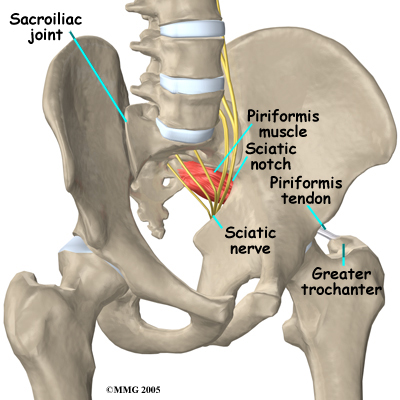 The piriformis muscle is one of the external rotators of the hip and leg. This means that as the muscle works, it helps to turn the foot and leg outwards when you are standing. The piriformis muscle can cause problems when spasm of the muscle irritates one of the large nerves innervating the leg, the sciatic nerve. The sciatic nerve is made up of the lower lumbar and sacral spinal nerves, which leave the spine and join to form the sciatic nerve. The sciatic nerve leaves the pelvis through an opening called the sciatic notch. The sciatic nerve runs under (and in some people through) the piriformis muscle on its way out of the pelvis. Tightness or spasm in this muscle can sometimes cause pain in the area of the muscle, or pain down the back of thigh in the area where the sciatic nerve innervates.
The piriformis muscle is one of the external rotators of the hip and leg. This means that as the muscle works, it helps to turn the foot and leg outwards when you are standing. The piriformis muscle can cause problems when spasm of the muscle irritates one of the large nerves innervating the leg, the sciatic nerve. The sciatic nerve is made up of the lower lumbar and sacral spinal nerves, which leave the spine and join to form the sciatic nerve. The sciatic nerve leaves the pelvis through an opening called the sciatic notch. The sciatic nerve runs under (and in some people through) the piriformis muscle on its way out of the pelvis. Tightness or spasm in this muscle can sometimes cause pain in the area of the muscle, or pain down the back of thigh in the area where the sciatic nerve innervates.
Related Document: Optimum Recovery Rehab Physical Therapy & Rehabilitation's Guide to Lumbar Spine Anatomy
Rationale
What does my doctor hope to achieve?
Your health care professional is recommending a piriformis muscle injection to try and determine if piriformis muscle spasm is the cause of your pain. This type of injection, which goes directly into the piriformis muscle, is primarily a diagnostic injection but may temporarily relieve your pain, sometimes just for a few hours. Once your health care professional is sure that it is the piriformis muscle causing your pain, other procedures may be recommended to reduce your pain for a longer period of time.
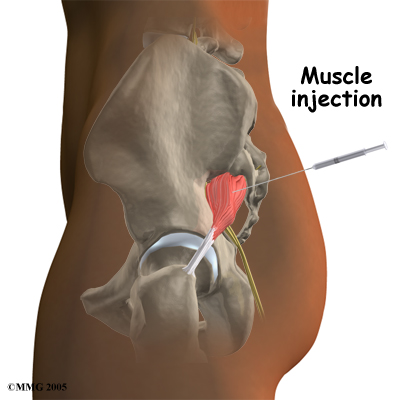
The piriformis muscle and tendon travel over the top of the sciatic nerve as the nerve leaves the pelvis at the sciatic notch. As mentioned above, spasm in the piriformis muscle can cause pain by squeezing against the sciatic nerve. This is particularly true if your anatomy is such that the sciatic nerve actually passes right through the muscle. The squeezing of the nerve causes the nerve to become irritated and inflamed - resulting in pain in the buttock and leg. This condition is referred to as piriformis syndrome.
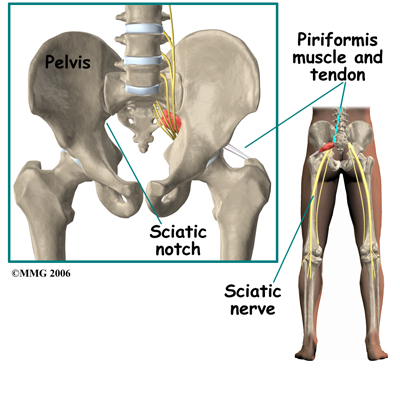
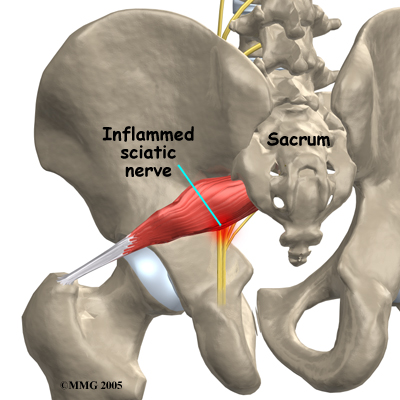
If the spasm continues, the muscle may become contracted (or shortened) which increases the pain and inflammation. To reverse the contracture, the muscle and tendon need to be stretched and lengthened back to normal. Paralyzing the muscle temporarily with an injection can make the stretching less painful, more effective, and speed up the process of lengthening the muscle and tendon.
If the stretching program fails to correct the problem, surgery to lengthen the tendon is an end-stage option. Before considering surgery, it is necessary to confirm the diagnosis as best as possible so the information from the injection is extremely important. If the injection temporarily relieves your symptoms, then the surgeon is more comfortable that the surgery is indicated and has a good chance of helping your problem. If the injection does not help, then some other cause of your symptoms may need to be considered.
During a piriformis muscle injection, the medications that are normally injected include a local anesthetic and cortisone. The anesthetic medication, such as lidocaine or bupivicaine, is the same medication used to numb an area when you are having dental work or having a laceration sutured. The medication causes temporary paralysis of the piriformis muscle lasting one hour to six hours, depending on which type of anesthetic is used.
Cortisone is an extremely powerful anti-inflammatory medication. When this medication is injected into a painful, inflamed muscle, it can reduce the inflammation and swelling. Reducing the inflammation reduces pain. If cortisone is also injected into the piriformis muscle at the same time, you may get several weeks' worth of relief from your pain. This can allow you to get started with or resume a physical therapy program, which will assist in stretching the piriformis muscle to reduce the contracture and the spasm in the muscle, and strengthening the weaker gluteal muscles that caused the piriformis to overwork in the first place.
Preparation
How will I prepare for the procedure?
To prepare for the procedure your doctor may tell you to remain "NPO" for a certain amount of time before the procedure. This means that you should not eat or drink anything for the specified amount of time before your procedure. This means no water, no coffee and no tea; nothing should be ingested. You may receive special instructions to take your usual medications with a small amount of water. Check with your doctor if you are unsure what to do.
You may also be instructed to discontinue certain medications that affect the clotting of your blood several days before the injection. This reduces the risk of excessive bleeding during and after the injection. These medications may include the common Non-Steroidal Anti-Inflammatory Drugs (NSAIDs) such as aspirin, ibuprofen, naproxen, and many other medications that are commonly used to treat arthritis. If you are taking any type of blood thinning medication you should let your doctor know. You will most likely need to have this medication regulated or temporarily discontinued prior to the injection. Your doctor will need to determine if it is safe to discontinue these medications in order to have the injection.
You may need to arrange to have transportation both to and from the location where you will undergo the injection. Wear loose fitting clothing that is easy to take off and put on. You may wish to take a shower the morning of the procedure using a bactericidal soap to reduce chances of infection. Do not wear jewelry or any type of scented oils or lotions.
Procedure
What happens during the procedure?
When you are ready to have the injection, you will be taken into the procedure area and an IV will be started. The IV allows the nurse or doctor to give you any medications that may be needed during the procedure. The IV is for safety purposes as it allows a very rapid response if there is a problem during the procedure, such as an allergic reaction to any of the medications injected. If you are in pain or anxious, you may also be given medications through the IV for sedation during the procedure.
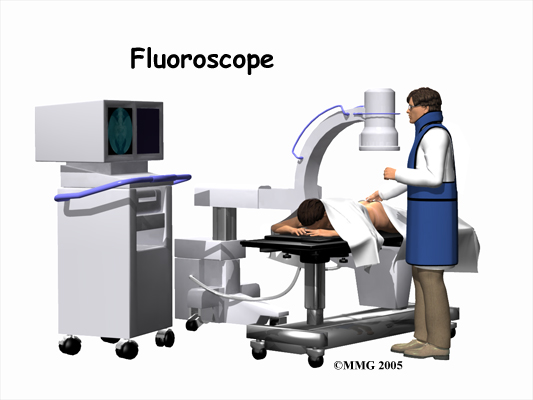 Piriformis muscle injections are done with the help of fluoroscopic guidance. The fluoroscope is an x-ray machine that allows the doctor to actually see an x-ray image while doing the procedure. This allows the doctor to watch where the needle goes as it is inserted. This makes the injection much safer and much more accurate. Once the needle is in the right location, a small amount of radiographic dye is injected. This liquid dye shows up on the x-ray image and the doctor can watch where it goes. The medication used for the injection will go in the same place, so the doctor wants to make sure that the medication goes to the best place to do the most good. Once the correct position is confirmed, the medication is injected and the needle is removed.
Piriformis muscle injections are done with the help of fluoroscopic guidance. The fluoroscope is an x-ray machine that allows the doctor to actually see an x-ray image while doing the procedure. This allows the doctor to watch where the needle goes as it is inserted. This makes the injection much safer and much more accurate. Once the needle is in the right location, a small amount of radiographic dye is injected. This liquid dye shows up on the x-ray image and the doctor can watch where it goes. The medication used for the injection will go in the same place, so the doctor wants to make sure that the medication goes to the best place to do the most good. Once the correct position is confirmed, the medication is injected and the needle is removed.
You will then be taken out of the procedure room to the recovery area. You will remain in the recovery area until the nurse is sure that you are stable and have not had an allergic reaction to the medications. The anesthetic may cause some temporary numbness and weakness. You will be free to go when these symptoms have resolved.
After Care
What happens after the procedure?
If everything goes as planned, you will be able to go home soon after the injection, probably within one hour. As with most types of pain injections, you will likely not have any restrictions on activity or diet following the procedure.
Seeing as the piriformis injection is mainly a diagnostic injection, your healthcare professional will be interested in how much the pain is reduced while the anesthetic, or the numbing medication, is working. You may be given a pain diary to record what you feel for several hours after the injection. You should rate your pain on a scale of 0-10 during this time, with 0 being no pain, and 10 being the worst pain you have ever felt. Tracking your comfort level while the anesthetic is still working is important for making decisions regarding the next steps in treatment for your pain, so keep close track of any discomfort as best you can.
Most doctors will arrange a follow-up appointment, or phone consult, within one or two weeks after the procedure to see how you are doing and what effect the procedure had on your symptoms.
It is recommended that you begin to see a physical therapist at Optimum Recovery Rehab Physical Therapy & Rehabilitation after your injection (if you haven’t seen one before), or return for further treatment with your usual therapist if you have already been working with one.
Post-injection Rehabilitation
Treatment at Optimum Recovery Rehab Physical Therapy & Rehabilitation after a piriformis injection can begin as soon as your doctor allows it. Each doctor will set their own time frames for beginning therapy based on their personal experience, and also based on how your body has reacted to the injection.
If the injection has relieved some or all of your discomfort then, if possible, it is useful to begin treatment at Optimum Recovery Rehab Physical Therapy & Rehabilitation during the period where you are in less pain. This time frame allows your physical therapist to take advantage of the pain-free period to stretch your piriformis muscle and to set you up on an individualized home exercise program of stretching and strengthening.
In order to help lengthen and relax a tight or contracted piriformis muscle your therapist may use hands on massage or stretching techniques as well as warm hot packs and electrical modalities such as ultrasound, interferential current, or electrical muscle stimulation. In some cases of lingering pain, ice may also be useful. If your therapist practices a type of needling, such as acupuncture or intramuscular stimulation, then they may also use this technique to assist with your pain and to help release any muscle tension.
Your physical therapist will prescribe a series of stretching exercises for your hip, buttocks, thigh, low back and, if necessary, your calf. They will also assess the motion of your hip joint. Any tightness in the muscles around the hip and knee or restricted motion in the hip joint itself can affect the biomechanics of the trunk and lower limb, including the tension in the piriformis muscle, so this will need to be addressed. In particular your therapist will encourage you to specifically stretch your piriformis muscle by sitting in a chair or on the ground and crossing the ankle of your affected side over your other knee. By applying gentle pressure downwards on the inside of your thigh of the affected side, while simultaneously sitting up tall (gently tilting your pelvis forward) you will be stretching your piriformis. Your therapist can advise you depending on your individual situation about how often you should be stretching your piriformis muscle and for how long you should hold each stretch. In general doing a long, steady hold of the piriformis stretch will improve flexibility of the piriformis muscle as well as improve the external rotation motion at your hip.
The cause of the initial spasm of your piriformis muscle will need to be investigated by your therapist. In order to assess this they will want to look at your overall posture in standing and sitting and may ask you to do activities like walk, jump, go up or down stairs, or squat on one leg in order to determine your particular pattern of motion and to assess which muscles may be weak or overbearing. In particular the alignment of your pelvis and lower limb will be assessed. Your hip joint, including the piriformis muscle along with the deep gluteal muscles, help to control the position of your lower limb as well as your pelvis. If your muscles are tight or weak they can alter your alignment and biomechanics and if your biomechanics or alignment are off, this can affect the tension in your piriformis muscle.
Your physical therapist will also assess the motion in your lumbar spine and pelvis as well as the ability of your core muscles to control the trunk. Due to the close proximity of the piriformis muscle to the low back area as well as the relation of the spinal nerves leaving the low back and then forming the large sciatic nerve (which, as explained above, passes near or through the piriformis muscle) this area needs to closely be assessed for its contribution to your dysfunction in the piriformis muscle. If your low back is stiff or degenerating at the joints this can irritate the nerves in the low back or alter the biomechanics of the spine causing the piriformis muscle to become tight. Alternatively a loose (hypermobile) low back joint can also alter the biomechanics of the low back and trunk causing the piriformis to tighten. Often by changing the overall biomechanics of the trunk and lower extremities the piriformis muscle is relieved of excess strain and your pain eases. You therapist will provide advice regarding your individual biomechanics and how you can improve them in your daily activities of work and play.
Having a weak core muscle area can have a similar effect on the lumbar and trunk biomechanics as a stiff or loose lumbar spine and can also lead to pain in the piriformis muscle. Core-strengthening exercises will be crucial to your rehabilitation after a piriformis injection. Your therapist may start these exercises by first just teaching you how to activate the deep muscles that support the spine and trunk. This is done by gently pulling the muscles inwards as you sit or lie on the bed. Pain and injury can make these muscles much less effective and difficult to activate so learning to use them may not be easy at first; the feedback from your physical therapist regarding technique will be crucial.
As you improve in your control of your core muscles then more difficult exercises such as ones where you are moving your arms or legs while you keep your trunk steady, will be prescribed in order to challenge this area. Lastly, improving the endurance of your core area will be of focus.
Generally the rehabilitation we provide at Optimum Recovery Rehab Physical Therapy & Rehabilitation after piriformis injections goes very well. If, however, your therapy is not progressing as your therapist believes it should, we may send you back to your doctor for another consult regarding further management of your pain. It is important to remember, however, that injections are not usually a cure for your pain; they are only a part of your overall pain management plan.
Optimum Recovery Rehab Physical Therapy & Rehabilitation provides services for physical therapy in West Orange.
Complications after piriformis injection
What might go wrong?
Piriformis injection procedures are safe and unlikely to result in a complication, but no procedure is 100% foolproof. This document doesn't provide a complete list of the possible complications, but it does highlight some of the most common problems. Complications are uncommon, but you should know what to watch for if they occur.
Like most procedures where medications are injected, there is always a risk of allergic reaction. The medications that are commonly injected include lidocaine, bupivicaine, radiographic dye, and cortisone. Allergic reactions can be as simple as developing hives or a rash. They can also be life threatening and restrict breathing. Most allergic reactions will happen immediately while you are in the procedure room so that help is available immediately. Most reactions are treated and cause no permanent harm. You should alert your doctor if you have known allergies to any of these medications.
Several types of infections are possible complications of piriformis injections. Any time a needle is inserted through the skin, there is a possibility of infection. Before any injection is done, the skin is cleansed with a disinfectant and the health care provider doing the injection uses what is called sterile technique. This means that the needle as well as the area where the needle is inserted remains untouched by anything that is not sterile. The provider may also use sterile gloves.
Infections can occur just underneath the skin, in the muscle, or in the deep tissues of the buttock. Signs of infection are increasing redness, swelling, pain, and fever. Almost all infections will need to be treated with antibiotics. If an abscess forms, then a surgical procedure may be necessary to drain the pus in the abscess as well as antibiotics to treat the infection.
Not all injections work as expected. Sometimes injections cause more pain. This may be due to increased spasm in the muscles around the injection site. The increased pain is usually temporary, lasting a few hours or a few days. Once the medication has a chance to work, the injection may actually perform as expected and reduce your pain. Increased pain that begins several days after the injection may be a sign of infection so if this occurs, alert your health care professional.
Portions of this document copyright MMG, LLC
 Piriformis muscle injections are commonly used to determine what is causing buttock and sciatica type pain. Piriformis muscle injections are both diagnostic injections and therapeutic injections, meaning that they can both help your health care professional determine the cause of your pain and may also provide you with relief from the pain. These injections work to eliminate pain temporarily by paralyzing the piriformis muscle and stopping spasm in the muscle. If the piriformis muscle is injected and your pain goes away for several days, then it is very likely that a portion of your pain is caused by piriformis syndrome. Once you and your health care professional know what structure is causing your pain, you can begin to explore options for treating the condition.
Piriformis muscle injections are commonly used to determine what is causing buttock and sciatica type pain. Piriformis muscle injections are both diagnostic injections and therapeutic injections, meaning that they can both help your health care professional determine the cause of your pain and may also provide you with relief from the pain. These injections work to eliminate pain temporarily by paralyzing the piriformis muscle and stopping spasm in the muscle. If the piriformis muscle is injected and your pain goes away for several days, then it is very likely that a portion of your pain is caused by piriformis syndrome. Once you and your health care professional know what structure is causing your pain, you can begin to explore options for treating the condition.










 The piriformis muscle is one of the external rotators of the hip and leg. This means that as the muscle works, it helps to turn the foot and leg outwards when you are standing. The piriformis muscle can cause problems when spasm of the muscle irritates one of the large nerves innervating the leg, the sciatic nerve. The sciatic nerve is made up of the lower lumbar and sacral spinal nerves, which leave the spine and join to form the sciatic nerve. The sciatic nerve leaves the pelvis through an opening called the sciatic notch. The sciatic nerve runs under (and in some people through) the piriformis muscle on its way out of the pelvis. Tightness or spasm in this muscle can sometimes cause pain in the area of the muscle, or pain down the back of thigh in the area where the sciatic nerve innervates.
The piriformis muscle is one of the external rotators of the hip and leg. This means that as the muscle works, it helps to turn the foot and leg outwards when you are standing. The piriformis muscle can cause problems when spasm of the muscle irritates one of the large nerves innervating the leg, the sciatic nerve. The sciatic nerve is made up of the lower lumbar and sacral spinal nerves, which leave the spine and join to form the sciatic nerve. The sciatic nerve leaves the pelvis through an opening called the sciatic notch. The sciatic nerve runs under (and in some people through) the piriformis muscle on its way out of the pelvis. Tightness or spasm in this muscle can sometimes cause pain in the area of the muscle, or pain down the back of thigh in the area where the sciatic nerve innervates.


 Piriformis muscle injections are done with the help of fluoroscopic guidance. The fluoroscope is an x-ray machine that allows the doctor to actually see an x-ray image while doing the procedure. This allows the doctor to watch where the needle goes as it is inserted. This makes the injection much safer and much more accurate. Once the needle is in the right location, a small amount of radiographic dye is injected. This liquid dye shows up on the x-ray image and the doctor can watch where it goes. The medication used for the injection will go in the same place, so the doctor wants to make sure that the medication goes to the best place to do the most good. Once the correct position is confirmed, the medication is injected and the needle is removed.
Piriformis muscle injections are done with the help of fluoroscopic guidance. The fluoroscope is an x-ray machine that allows the doctor to actually see an x-ray image while doing the procedure. This allows the doctor to watch where the needle goes as it is inserted. This makes the injection much safer and much more accurate. Once the needle is in the right location, a small amount of radiographic dye is injected. This liquid dye shows up on the x-ray image and the doctor can watch where it goes. The medication used for the injection will go in the same place, so the doctor wants to make sure that the medication goes to the best place to do the most good. Once the correct position is confirmed, the medication is injected and the needle is removed.